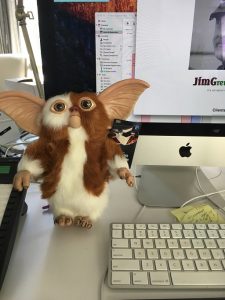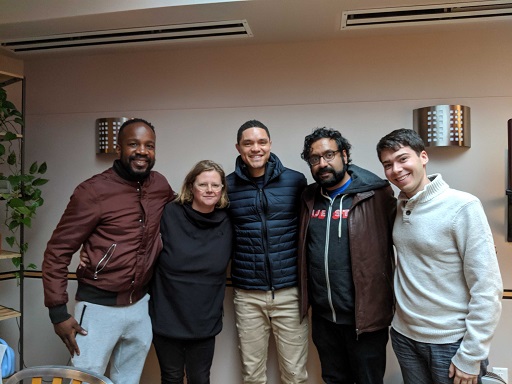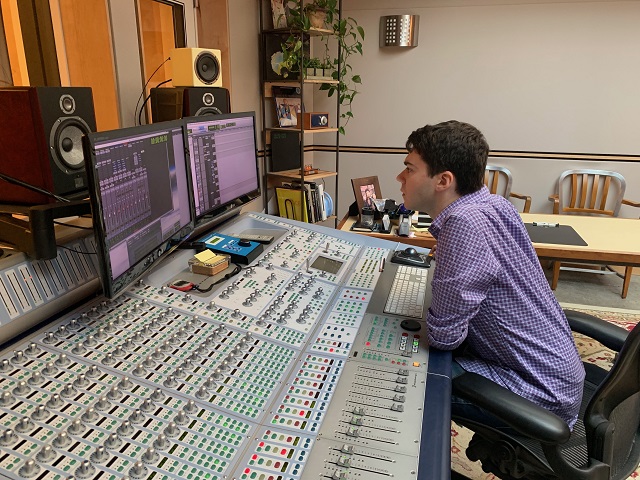by LindaAnn LoSchiavo for L’IDEA
Every day, you’ll encounter a voice actor and perhaps not even realize it. Indeed the voice-over industry is expanding beyond radio, audio-books, corporate training, explainer ads, and public service announcements.
Take a moment to appreciate how a variety of quirky aural mannerisms brought to life favorite cartoon creatures. Mel Blanc, “the man of a 1,000 voices,” for instance, portrayed Bugs Bunny, Daffy Duck, Porky Pig, and numerous characters from the Looney Tunes and Merrie Melodies franchise.
Popular screen stars have also portrayed animated figures. Here are some examples. Mila Kunis is the voice behind Meg Griffin, the teenage daughter on TV series Family Guy. In Fantastic Mr. Fox, his wife Felicity was played by Oscar winner Meryl Streep. Comedian Mike Myers voiced Shrek. And what about Aladdin, Disney’s 1992 movie that inspired a Broadway musical? Actor Scott Weinger lent his vocal chops to the orphan boy. And the late Robin Williams, whose impersonations sparked joy in numerous animated films, won awards for “Best Comedic Performance in a Movie” for his masterful portrayal of both the peddler and Aladdin’s Genie.
Whether your goal is an Oscar or a signature cartoon persona, voice acting can be an enjoyable career in a growing industry. As the world has become digital, the demand for voice talent has increased along with the pay.
Let’s meet a voice actor and learn more about this versatile vocation.
Hailing from Lower Merion, PA, and now living in New York City, Dylan Dagenais explained his background: a knack for music (drums, guitar) as a child; an interest in musical theatre and Commedia dell’Arte in adolescence; a theatre major at Emerson College, earning a BFA in musical theatre; and an enviable resume of stage and TV credits amassed while learning how to score and produce.
Serendipity arrived. He enrolled in an “Introduction to Audio” course at Emerson, taught by the inimitable John Krivit.“This really opened my eyes to the possibility of another interesting and challenging career path,” Dagenais remembered. Several classmates, deciding audio was their niche, formed a support group. Recently, “Mo Herbert released a fantastic album called No Fires under their moniker Mount Planet. It’s something special,” he added.
Relocating to Manhattan opened doors. During an internship at a recording studio/post-production house, he was soon hired as a producer. “Suddenly, I was working on very high-profile projects with personalities I had only seen on TV.”
One challenge became the clientele on a tight budget. Dagenais explained, “We often needed to find more affordable (i.e., local) talent options for certain projects.” As the saying goes, necessity is the mother of invention — or self-invention.
“Since I was spending all day listening to voice-over,” he said, “I had picked up on the rhythms of VO (aided by my background in music and acting). Thus I ended up recording several advertisements for the company. VO is one of many things I do. But it has brought many chances to work with amazing people, which, to me, is one of the biggest draws for any profession.”
Although the scope of a voice actor can be quite broad, Dagenais explained how he drilled down into his own priorities. “While I still love acting in films and enjoy being on a set, I generally don’t do too much stage work any longer due to the time commitment and the demands of the projects.”
His chosen specialty is the sci-fi and horror genre. He said, “My apartment is filled with horror movies and I keep a Mogwai puppet and a Starfleet com-badge on my desk. I do a podcast about monster movies with a friend of mine (Hot for Creature). Since I’ve always been passionate about genre films and literature, I think the love I have for that kind of media is revealed in the work I do.” He noted, “I believe all actors do their best work on projects they really love.”

Opportunity came knocking when he relocated to The Big Apple. He recalled, “After I moved to the city, some projects I worked on were truly surreal in scope. For instance, Trevor Noah would record his podcast at the studio where I worked. Naturally, every Sunday I took advantage of that, making an effort to be there in the room coordinating or engineering.”
Dagenais explained how to make serendipity your wing-man. “When an opportunity to work with a talent such as Trevor Noah presents itself, you take it seriously. And because Trevor is such a consummate professional, I learned a great deal about hosting a podcast just by observing him. I implemented that knowledge in Hot For Creature.

Another memorable opportunity presented itself when Dagenais engineered some remote recording sessions for the 2019 sci-fi film Dark Waters. He valued the experience of working with its director, Todd Haynes. He recalled, “We had a great conversation about his film Velvet Goldmine (a favorite of mine). Mr. Haynes was extraordinarily smart as well as down-to-earth.”
“Memorable”may be what goes awry, too. Dagenais recalled one session of Trevor Noah’s On Second Thought, a podcast. “During a record-breaking heatwave, the air conditioner died. I was freezing water bottles for the crew and distributing ice-cold soda cans. Special kudos must go to Trevor and David Kibuuka and their guest because sound-proof booths can feel like an oven during summer.”
Whereas a podcast can be wrapped in a day, an audio-book will take longer. According to Dagenais, recording a novel might require one to six months. He clarified, “The book’s length is a factor. But what takes the most time are revisions and back and forth.” The sheer enjoyment of working with writers, he felt, has made the process more personal. He added, “I’ve been lucky to work with talented authors and audio professionals whose goal is producing an outstanding finished product.”
However, time management is an on-going concern for any freelancer. “Sometimes you’re flooded,” admitted Dagenais, “other times you’re wandering the desert. Though my freelance projects have been exciting, a part of me appreciates being a working stiff at a regular gig.”
What are the tools of the trade? Dagenais suggested this equipment, especially since remote work will become more common: a high-quality condenser microphone and pre-amp. Additionally, in New York, though it is difficult to make a space sonically friendly, insulation and sound absorption can be improved easily and inexpensively. “I personally record,” he said,” on an AT4040 with a Focusrite pre-amp.”

To anyone contemplating a career in voice-over, he has advice. “Unlike a screen star trying to maintain an autonomy over how s/he will portray a character, it’s the opposite in voice acting. “In VO, you are there to do a job and give clients what they want,” he emphasized. “Even if it’s a widely seen project you are not proud of, you may think, ‘That’s not me.’ But the client wants you to give them what they want as quickly and pleasantly as possible. And your job is to do that. The goal is: do the kind of work that gets you more work, while being polite and nice. My advice to students who want an entry point into VO is: keep that client-focused model in mind. In the end, it’s not about you.” He added, “For some animated films or campaigns, folks have invested time and money into the spot. Studio time is expensive. They don’t have time to argue about the performance they want. But if you give them what they want, quickly and easily, they will know that hiring you was a good investment.”
Despite a hectic schedule, Dagenais squeezes in his own projects, one of which is a folk musical based on a famous horror novel. During the pandemic lockdown, he wrote and recorded it, receiving kudos from composers and theatre-makers. Currently, he’s negotiating rights and hopes to proceed with his dream come true.・
Hear samples of his work on YouTube:
Unquiet House
“Poe and His Women”
The Son-in-Law from Hell
Podcast
Dylan Dagenais is happy to discuss your project. Contact him via email < [email protected] > or on Twitter @dylandagenais25 or on LinkedIn.






